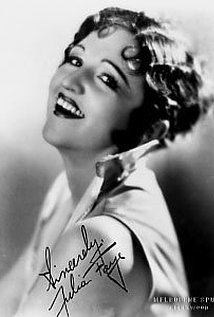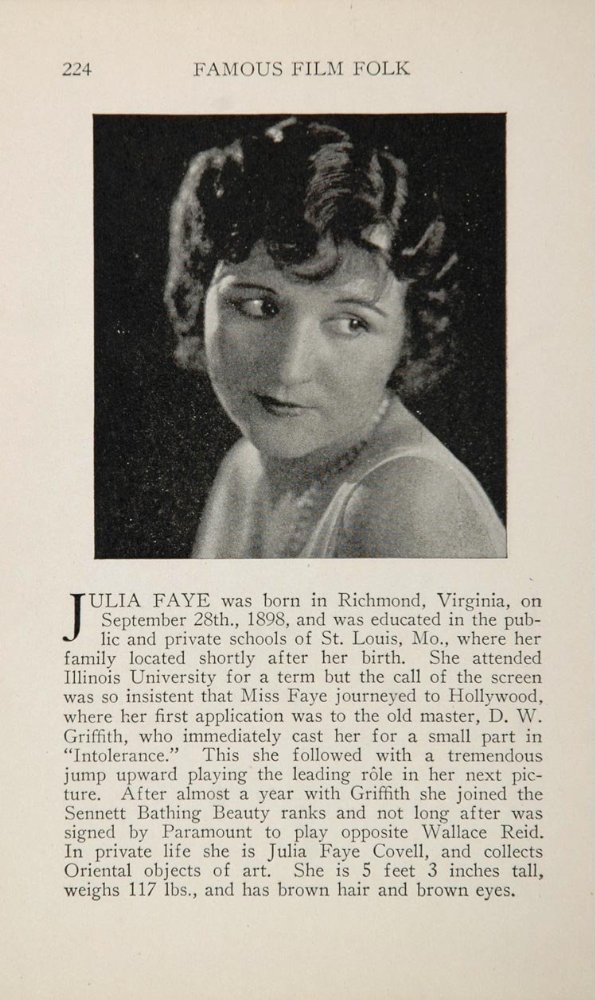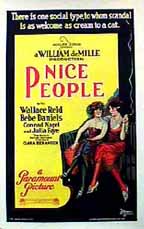
Julia Faye
Birthday:
24 September 1892, Richmond, Virginia, USA
Birth Name:
Julia Faye Maloney
Height:
159 cm
Julia Faye's career is inextricably linked to director Cecil B. DeMille. He was her mentor, while she was for many years his mistress (a liaison which was tolerated by De Mille's long-suffering wife Constance Adams). Julia was born in Richmond, Virginia, of French-American parentage. She had a Southern drawl which she never lost. When she...
Show more »
Julia Faye's career is inextricably linked to director Cecil B. DeMille. He was her mentor, while she was for many years his mistress (a liaison which was tolerated by De Mille's long-suffering wife Constance Adams). Julia was born in Richmond, Virginia, of French-American parentage. She had a Southern drawl which she never lost. When she was six months old her family moved to St. Louis, MO, where she spent most of her early childhood. She was educated at Illinois State University. Her parents intended for her to have a teaching career, but Julia had other ideas. She started out as a model for fashion magazines, touted as "the girl with the perfect legs" and "the prettiest feet and ankles in America". Her photo shoots did not escape the attention of De Mille, who summoned her for an audition (though, according to author Charles Higham, it was actor Wallace Reid who first introduced Julia to De Mille at a party). Her "pegs" certainly passed muster and Julia was fast-tracked to the silver screen, initially appearing in a few small roles at Fine Arts=Paramount. Casting directors were also eager to utilize her as a "leg model", doubling for actresses deemed less endowed in that department. In 1916 Julia moved to Keystone as one of Mack Sennett's Bathing Beauties and knockabout comediennes, occasionally as leading lady and at times performing her own stunts.Despite limitations to her acting ability, Julia was possessed of sophistication, wit and charm. which contributed to her having a pretty good career for the better part of the 1920s. She was featured in billed supporting roles in a number of De Mille's big-budget extravaganzas, including The Ten Commandments (1923) (as Pharaoh's wife), The Volga Boatman (1926) (as a gypsy) and The King of Kings (1927) (as Martha). Dynamite (1929), co-scripted by another De Mille protégé and mistress (not to mention fierce rival), Jeanie Macpherson, gave Julia her best opportunity to shine in a meatier role. However, by the early 1930s her career was already in decline. Perhaps hoping to emulate Macpherson, she proceeded to study screenwriting for three years under De Mille's tutelage, but, in the end, to little avail. Eventually, offers from Hollywood dried up and her money ran out. To his credit, De Mille continued to support Julia by putting her on the payroll as one of his regular stock players. She went on to appear in cameos and bit parts in his films for another two decades, usually without dialogue. Her last film role was as a dowager in The Buccaneer (1958).Julia Faye died in April 1966 at the age of 72. She has a star on the Hollywood Walk of Fame. Show less «
I don't mind playing bad women at all. I only wish they would let me make them human. A bad woman with a sense of humor - some of the qualit...Show more »
I don't mind playing bad women at all. I only wish they would let me make them human. A bad woman with a sense of humor - some of the qualities of reality. Show less «
Belasco said, "Before you can act, you must learn how not to act!" That is so true! Overacting is the bane of the profession!
Belasco said, "Before you can act, you must learn how not to act!" That is so true! Overacting is the bane of the profession!
Acting is not a matter of the emotion of the player. It is a matter of technique. It does not matter in the least what the player feels - it...Show more »
Acting is not a matter of the emotion of the player. It is a matter of technique. It does not matter in the least what the player feels - it is what he makes his audience feel that is important. And there are certain tricks of gesture and expression which we know by experience produce certain effects. If we master the mechanics of our profession, we can do what we will with our public. Show less «
[when asked if she would like to play ingénue roles] Heaven forbid! I should like to play leads, of course. It gives one so much wider scop...Show more »
[when asked if she would like to play ingénue roles] Heaven forbid! I should like to play leads, of course. It gives one so much wider scope. But I am a character woman and I want to remain one. Show less «
Sometimes you don't even know what is best for yourself. An actor is too close to his profession to have any perspective on it. That is why ...Show more »
Sometimes you don't even know what is best for yourself. An actor is too close to his profession to have any perspective on it. That is why so many independently producing stars fail. They may please themselves and their vanity by doing what they want to, but nine cases out of ten they leave their audiences cold. Show less «
[in 1924] For three years I have been studying screen writing - the adaptation, the technique, all there is to know about it; so, if I ever ...Show more »
[in 1924] For three years I have been studying screen writing - the adaptation, the technique, all there is to know about it; so, if I ever quit the screen as an actress, I will become a writer. Under the tutelage of Cecil B. DeMille, whom I believe to be the world's greatest director, I am learning screen writing. He has aided, and is continuing to aid, me in many ways. Some day I expect to write pictures for him to produce. He certainly has encouraged such an ambition. For three years I have studied, but I am waiting before I start my career until I am sure of myself, of my ability. Then I will write stories with a lesson, every picture with a moral, because I think the screen is the world's greatest educational medium. Show less «
There was a role of an innocent little country girl in His Dog (1927), and they wanted me to do it. That is, they wanted me to and they didn...Show more »
There was a role of an innocent little country girl in His Dog (1927), and they wanted me to do it. That is, they wanted me to and they didn't want me to. There was no one else that they could think of to do the part, and yet they were considerate enough to realize that it wouldn't do me any particular good. Mr. DeMille said, "I hate to ask you to take this part. You will be very mis-cast in it and it won't be fair to you." In spite of all that, I accepted the part. Just to show you how easy it is for even the smart ones to be wrong, there have been more comments from exhibitors on my work in that picture than any since The Volga Boatman (1926). Show less «
People have advised me that I am making a mistake to accept such small roles, but I have proved to myself that it is not an unwise thing to ...Show more »
People have advised me that I am making a mistake to accept such small roles, but I have proved to myself that it is not an unwise thing to do. I think one good flash is better than a whole picture of a stupid role. I can remember certain bits in other pictures that have stayed with me long after I have forgotten the star's part. One good individual scene has made many stars. Show less «
If you can't work in a part you believe in yourself, then the next best thing is to work in a picture someone else believes in.
If you can't work in a part you believe in yourself, then the next best thing is to work in a picture someone else believes in.
I am not the particular star type that can rush in and make an audience believe in a perfectly unbelievable character. I want to do the huma...Show more »
I am not the particular star type that can rush in and make an audience believe in a perfectly unbelievable character. I want to do the human things I can believe in myself. Show less «
[on the time when she worked for D.W. Griffith] We got $25 a week and played in any and everything. I always had good looking clothes and Gr...Show more »
[on the time when she worked for D.W. Griffith] We got $25 a week and played in any and everything. I always had good looking clothes and Griffith hired those, too, but not for me to wear. He rented them for his leading players. Why, once I took off my hat and let Norma Talmadge wear it in a scene, and made $5 on the rental. Show less «
[on how she introduced William Boyd to Cecil B. DeMille during the filming of Saturday Night (1922)] I dived into a swimming pool and Boyd l...Show more »
[on how she introduced William Boyd to Cecil B. DeMille during the filming of Saturday Night (1922)] I dived into a swimming pool and Boyd leaned over the edge and whispered a warning that my suit straps had slipped. The scene was ruined and DeMille was furious. But when I explained what happened, DeMille took a liking to Bill, gave him a bit part, and eventually made him a star. Thus "Hopalong Cassidy" was born. Show less «
NEXT PAGE

Eliseba











